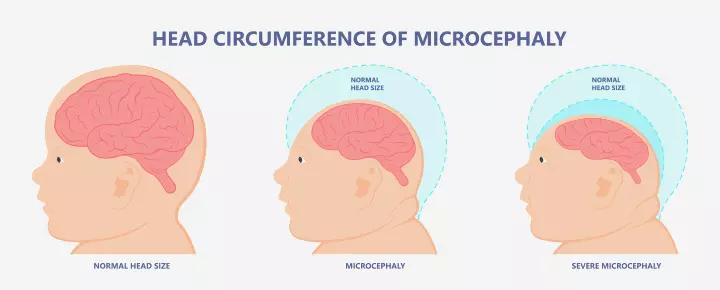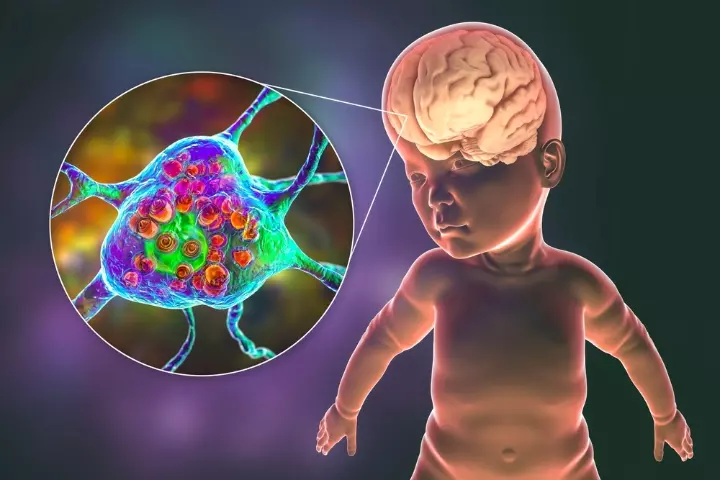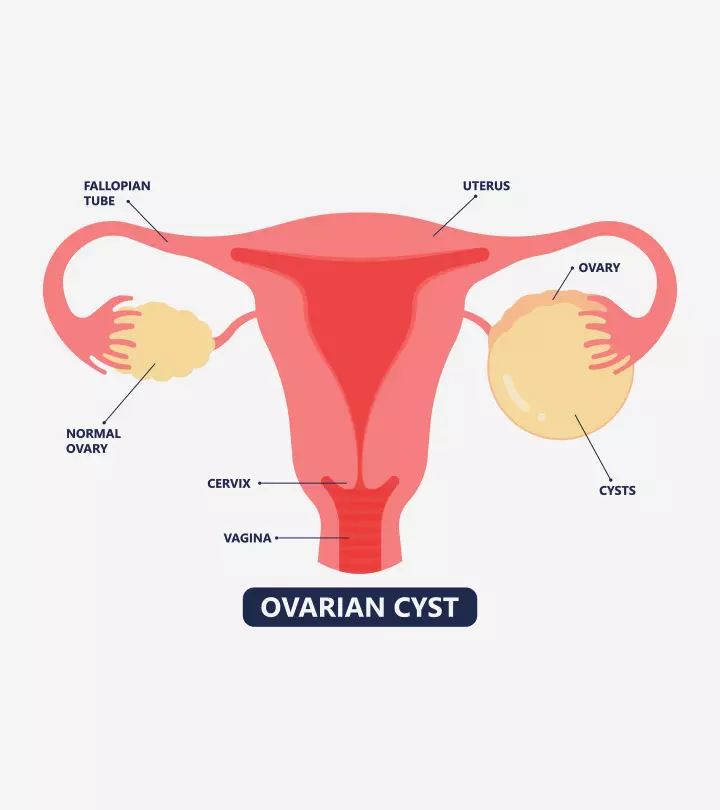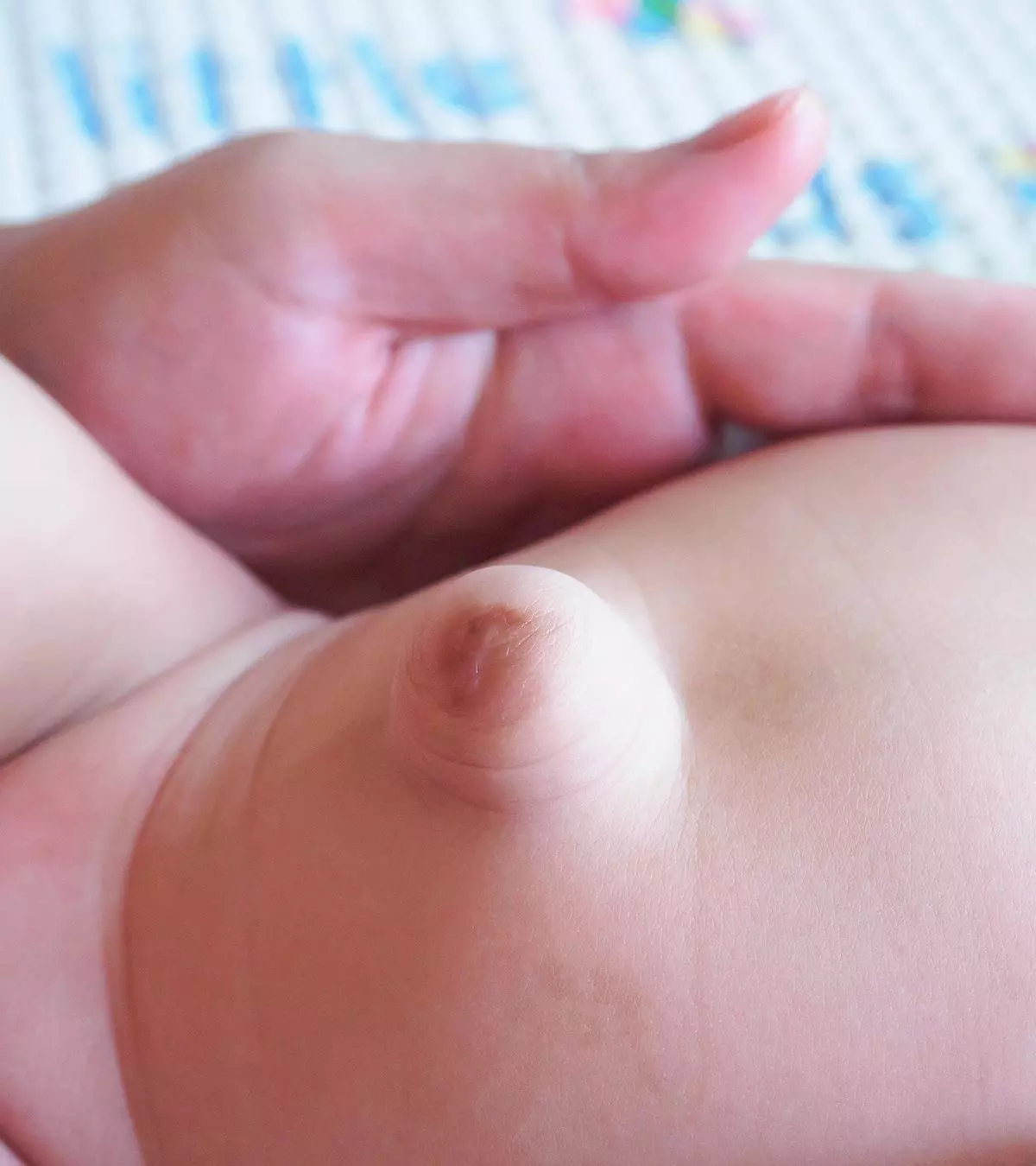
Image: Shutterstock
Macrocephaly in babies is characterized by a disproportionate and abnormally large swelling of the skull. It is also known as large head syndrome or big head. Often, it is a sign of an underlying problem and can be diagnosed by measuring the baby’s head circumference and comparing it to growth charts.

Parents may be worried about the unusual appearance of macrocephaly. However, macrocephaly can be treated depending on the cause of the condition. The treatment can range from medications that help control the swelling to surgery.
Read this post to understand more about macrocephaly in babies, including the possible causes, diagnostic measures, and treatment options.
Key Pointers
- Macrocephaly is a health condition in which a baby’s head circumference becomes larger than usual for its age.
- Excess brain fluid, infections, congenital brain conditions, or genetic disorders are primary causes of macrocephaly.
- MRI, ultrasound, and CT scans are some of the methods used to examine macrocephaly.
- The usual treatments for macrocephaly include surgery or oral medication. However, genetic conditions cannot be cured and can only be managed.
What Is Macrocephaly?

Macrocephaly, also called big head or large head syndrome, is a pediatric condition that causes an abnormal increase in the head circumference of the baby. Not all babies have the same head circumference. Therefore, physicians divide head circumferences into different percentiles (1).
If the circumference falls within the healthy range for their age and gender, then it is considered normal. Medical experts define macrocephaly as a condition where the baby’s head circumference (in centimeters or inches) is greater than the 98th percentile (2). There could be several reasons for macrocephaly.
What Causes Macrocephaly In Babies?
Here are a few reasons why an infant could have an enlarged head or develop one (3):
- Hydrocephalus in babies is a neurological disorder that causes excessive cerebrospinal fluid to accumulate within the ventricles (spaces) of the brain, causing cerebral edema and elevated intracranial pressure (8). It is one of the most common brain disorders among infants (4). The excess fluid swells the skull. Hydrocephalus itself can occur due to several diseases ranging from congenital hydrocephalus to an injury or an infection.
- Nervous system infections can cause the brain and cranial enlargement. Examples include meningitis, an infection of the membrane covering the brain, and encephalitis, a severe inflammation of the brain tissue. Infections can develop due to pathogens such as bacteria and viruses.
- Rickets is caused due to the deficiency of vitamin D in the body. Rickets cause abnormalities of the skeletal system including bones of the skull. The skull can expand in size causing a big head (5).
- Brain disorders: Problems such as a brain tumor, can cause a large head in babies. Some congenital deformitiesiA structural or functional abnormality present from birth. of the brain that can cause macrocephaly are hydranencephaly (lack of cerebrum) and megalencephaly (abnormal increase in brain matter).
 Quick fact
Quick fact
- Genetic disorders: Defective genes can also cause macrocephaly. One of the most notable ones is Sotos syndrome. It is a genetic disorder that affects the skeleton leading to many problems including the development of an unusually large head (6). As a result of brain overgrowth, infants with autism may also display macrocephaly on attaining toddlerhood (7)(8).
Mel, a mom of two, provides insights into head control issues her younger son, Luke, has been facing due to macrocephaly caused by a rare genetic condition. She explains, “He’s been raising his head a little. When we have him on his tummy for tummy time, he doesn’t work particularly hard!! He’s pretty laid back!!! We are working on that. He is getting more and more solid as we are picking and holding him up. I have to keep reminding myself that it will take him a while to get good head control due to the macrocephaly (i).”
 Quick fact
Quick factThere could be situations where macrocephaly is a normal occurrence. In such cases, the baby will not display any health-related symptoms and will grow normally. There is nothing to worry about in such situations. Nevertheless, if you suspect the infant’s skull to be going out of shape and disproportionate to the body, then do not hesitate to see the pediatrician.
How Is Macrocephaly Diagnosed In Babies?
Physicians measure the height, weight, and head circumference of the infant and are likely to detect macrocephaly during a routine checkup in the first year of the baby’s life. Doctors will use the following tools to check for the underlying condition that led to a large head in babies:
- Physical examination: The doctor checks for the external appearance and feels the fontanelle (soft spot) on the baby’s skull. Some brain disorders like hydranencephaly can be diagnosed by illuminating the skull with a bright light. The doctor will also check for signs of internal bleeding that could suggest brain trauma.

- Observing other symptoms: Doctors check if the baby is irritable, has poor suckling reflexes, displays extreme lethargy, has abnormal eye movements, or shows symptoms of developmental delays. These symptoms could indicate a disability-causing genetic disorder.
- Ultrasound: An ultrasound can give a quick analysis of what lies beneath the skull. It can help doctors decide the further course of testing.
- CT scan: Computerized tomography scan, or CT scan, takes multiple X-rays of the skull to create a three-dimensional image. It is useful in examining the shape of the skull and identifying any skull deformity.
- MRI: Magnetic resonance imaging (MRI) uses a magnetic field to generate a highly accurate and elaborate image of the entire skull. While an MRI gives a detailed picture of macrocephaly, it requires the person to stay still.
So the doctors may use a bit of sedation to keep the infant still within the MRI scanner. Several hospitals now perform a “Quick MRI” without sedation, which is advisable for pediatric patients although this form of MRI has limited image rendering capabilities (8).
- Blood test and fluid collection: A blood test may help assess the presence of genetic disorders in children. The doctor may even collect a sample of the cerebrospinal fluid from the base of the spinal cord, using a procedure called spinal tap. The fluid may also be obtained from the top layers of the brain depending on the condition of the skull.

Once your doctor has the diagnosis, they will recommend the best course of treatment.
How Is Macrocephaly Treated?
The treatment of macrocephaly depends on the cause of the condition. Options include:
- Neurosurgery is often the only option in several causes of macrocephaly. The type of surgery will vary according to the extent of swelling and the reason. For instance, hydrocephalus involves draining the cerebrospinal fluid into the abdomen where the body can absorb it. This surgery is called shunt surgery, where a silicon tube is placed in brain fluid on one side and abdominal cavity on another side. But it does not cure the condition, as hydrocephalus is a permanent condition. In the case of brain trauma, surgery may help rectify the problem entirely.
- The doctor may provide oral medications to control the swelling of the brain tissue. Deficiency diseases like rickets can be cured by giving the baby the right dose of the nutrient.

- Macrocephaly due to genetic disorders does not have a cure and can only be managed. Several infants with incurable macrocephaly encounter some form of cognitive and physical disability along with complications like seizuresiSudden and abnormal surges of electrical activity in the brain characterized by jerking body movements and loss of consciousness. .
 Be watchful
Be watchfulYou can contact support organizations and trainers that specialize in dealing with infants with disabilities. Such resources can help train parents about coping with the condition and improving the infant’s quality of life.
Frequently Asked Questions
1. Can a child with macrocephaly be normal?
Yes, if many individuals in your family have a large head (macrocephaly), your child is meeting overall developmental milestones, and has a normal neurologic finding, it can be considered a normal and healthy condition. However, ensure to get your baby checked for any underlying medical condition (9). A regular check-up to monitor your baby’s head circumference and other associated symptoms can help in early intervention and better outcomes.
2. What are the symptoms of macrocephaly?
In the case of benign familial macrocephaly, the child will have an abnormal head size and no other symptoms. Otherwise, you may find symptoms such as rapid head growth, poor appetite, developmental delays, bulging spaces between the bones of your child’s skull, bulging veins on the head, a downward gaze of your child’s eyes, and other conditions such as autism (9).
3. Do babies outgrow macrocephaly?
Benign familial macrocephaly or benign extra-axial collections of infancy are considered harmless, and babies usually grow out of the condition by early childhood. However, treatment is required if an underlying medical condition is present along with macrocephaly (9). In some cases, a baby may have various developmental outcomes depending on the underlying condition and may require long-term treatment.
4. How is macrocephaly in babies monitored over time?
In babies, macrocephaly is monitored by measuring head circumference at each visit and plotting it on a growth chart along with a complete developmental assessment (12). Monitoring may also include observing accompanying signs such as swollen scalp veins, widening of the cranial sutures, and a large, firm, non-pulsating soft spot in the anterior fontanel (13).
5. What are the indications for neuroimaging in cases of macrocephaly in children?
Neuroimaging is required for the diagnosis of macrocephaly in children to visualize and study the different parts of the brain affected by the condition and determine the abnormality causing the increased circumference (14). Moreover, it is also necessary when macrocephaly needs to be distinguished from megalencephaly, where brain overgrowth exceeds double the standard deviation (15).
Macrocephaly in babies may occur due to the accumulation of excess fluids inside the head, infections causing inflammation, or deficiency diseases such as rickets that affect bones. Some cases may be benign, and the child grows without any health concerns. However, it is important to seek medical advice if your child’s head keeps growing. Corrective surgery may be suggested to drain out the extra fluid or in case of trauma. Reach out to specialized trainers and other resources to ensure a better quality of life for your child.
Infographic: Possible Reasons For Macrocephaly In Babies
Macrocephaly, or abnormally large head size, may indicate an underlying health issue in the baby. Early detection and treatment are essential in managing this condition. Read through the infographic below to learn about several causes that could be responsible for the development of macrocephaly in babies.
Some thing wrong with infographic shortcode. please verify shortcode syntax
Learn about the causes of macrocephaly in children, from genetic conditions to environmental factors. Understand the facts and the risks from an expert.
Personal Experience: Source
MomJunction articles include first-hand experiences to provide you with better insights through real-life narratives. Here are the sources of personal accounts referenced in this article.
i. Loving Luke;https://lovingluke1.blogspot.com/2010/06/
References
1. Macrocephaly; MSD Manual
2. Macrocephaly; Children’s Hospital at Dartmouth-Hitchcock
3. Large Heads (Macrocephaly); The University of Chicago
4. About Hydrocephalus; Stanford Medicine
5. Vitamin D; University of Rochester
6. Sotos syndrome; U.S. National Library of Medicine
7. Macrocephaly Syndromes; University of Florida
8. Macrocephaly – an overview; ScienceDirect Topics
9. K. Rozovsky et al., Fast-brain MRI in children is quick, without sedation, and radiation-free, but beware of limitations; National Center for Biotechnology Information
10. Stephen G. Jones and Debopam Samanta; (2025); Macrocephaly; U.S. National Library of Medicine.
11. Macrocephaly; Cleveland Clinic
12. Large Heads (Macrocephaly); The University of Chicago
13. Hydrocephalus; University of Hawaii
14. Emanuele Orrù et al.;The Child With Macrocephaly: Differential Diagnosis and Neuroimaging Findings; American Journal of Roentgenology
15. Ai Peng Tan et al.;Macrocephaly: Solving the Diagnostic Dilemma; NCBI
Community Experiences
Join the conversation and become a part of our nurturing community! Share your stories, experiences, and insights to connect with fellow parents.
Read full bio of Dr. Raashid Hamid
Read full bio of Rohit Garoo
Read full bio of Dr. Ritika Shah
Read full bio of Vidya Tadapatri
















